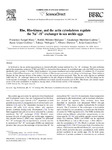
Please use this identifier to cite or link to this item:
http://ricaxcan.uaz.edu.mx/jspui/handle/20.500.11845/479Full metadata record
| DC Field | Value | Language |
|---|---|---|
| dc.contributor | 45084 | es_ES |
| dc.contributor.advisor | Francisco Rangel Mata | es_ES |
| dc.contributor.advisor | Guadalupe Martínez Cadena | es_ES |
| dc.contributor.advisor | Juana López Godinez | es_ES |
| dc.contributor.advisor | Takuya Nishigaky | es_ES |
| dc.contributor.advisor | Alberto Darszon | es_ES |
| dc.contributor.advisor | Jesús García Soto | es_ES |
| dc.contributor.other | 0000-0002-7243-2596 | es_ES |
| dc.coverage.spatial | Internacional | es_ES |
| dc.creator | Méndez Márquez, Rubén Octavio | - |
| dc.date.accessioned | 2018-01-25T19:08:35Z | - |
| dc.date.available | 2018-01-25T19:08:35Z | - |
| dc.date.issued | 2007-01-05 | - |
| dc.identifier | info:eu-repo/semantics/publishedVersion | es_ES |
| dc.identifier.issn | 0006-291X | es_ES |
| dc.identifier.issn | ESSN: 1090-2104 | es_ES |
| dc.identifier.uri | http://hdl.handle.net/20.500.11845/479 | - |
| dc.description.abstract | At fertilization, the sea urchin egg undergoes an internal pH (pHi) increase mediated by a Na+–H+ exchanger. We used antibodies against the mammalian antiporters NHE1 and NHE3 to characterize this exchanger. In unfertilized eggs, only anti-NHE3 cross-reacted specifically with a protein of 81-kDa, which localized to the plasma membrane and cortical granules. Cytochalasin D, C3 exotoxin (blocker of RhoGTPase function), and Y-27632 (inhibitor of Rho-kinase) prevented the pHi change in fertilized eggs. These inhibitors blocked the first cleavage division of the embryo, but not the cortical granule exocytosis. Thus, the sea urchin egg has an epithelial NHE3-like Na+–H+ exchanger which can be responsible for the pHi change at fertilization. Determinants of this pHi change can be: (i) the increase of exchangers in the plasma membrane (via cortical granule exocytosis) and (ii) Rho, Rho-kinase, and optimal organization of the actin cytoskeleton as regulators, among others, of the intrinsic activity of the exchanger. | es_ES |
| dc.language.iso | eng | es_ES |
| dc.publisher | Elsevier | es_ES |
| dc.relation | http://www.sciencedirect.com/science/article/pii/S0006291X06024831 | es_ES |
| dc.relation.ispartof | http://www.sciencedirect.com/science/article/pii/S0006291X06024831 | es_ES |
| dc.relation.uri | generalPublic | es_ES |
| dc.rights | CC0 1.0 Universal | * |
| dc.rights.uri | http://creativecommons.org/publicdomain/zero/1.0/ | * |
| dc.source | Biochemical and Biophysical Research Communications Vol. 352, Issue 1, 5 January, pp. 264–269 | es_ES |
| dc.subject.classification | BIOLOGIA Y QUIMICA [2] | es_ES |
| dc.subject.other | Egg Fertilization | es_ES |
| dc.subject.other | Na+–H+exchang | es_ES |
| dc.subject.other | Rho-kinase | es_ES |
| dc.subject.other | Cytoskeleton | es_ES |
| dc.subject.other | Exocytosis | es_ES |
| dc.subject.other | Sea urchin | es_ES |
| dc.subject.other | Erizo de mar | es_ES |
| dc.subject.other | Citoesqueleto | es_ES |
| dc.title | Rho, Rho-kinase, and the actin cytoskeleton regulate the Na+–H+ exchanger in sea urchin eggs | es_ES |
| dc.title.alternative | Rho, Rho-kinasa y la regulación del citoesqueleto de actina regula el intercambiador Na+–H+ en óvulos de erizo de mar | es_ES |
| dc.type | info:eu-repo/semantics/article | es_ES |
| Appears in Collections: | *Documentos Académicos*-- UA Ciencias Químicas | |
Files in This Item:
| File | Description | Size | Format | |
|---|---|---|---|---|
| Rho-Articulo_Maestia.pdf | 430,92 kB | Adobe PDF |  View/Open |
This item is licensed under a Creative Commons License
